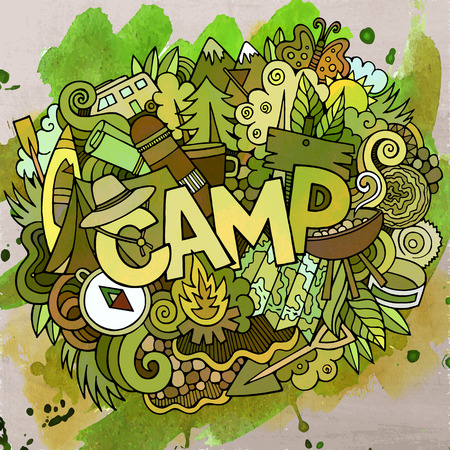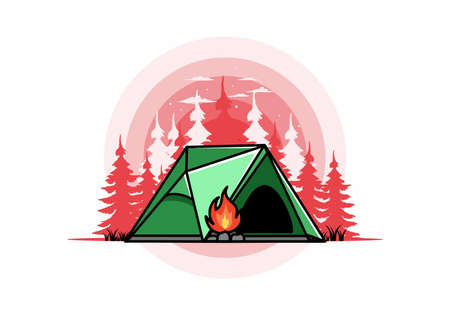Introduction to Woodland Campsites in the UK
Woodland campsites are a cherished part of Britain’s landscape, offering families and educators a unique setting for outdoor adventures and learning. Nestled within ancient forests or hidden pockets of native woodland, these campsites provide children with an authentic connection to nature—an experience that is becoming increasingly valuable in our fast-paced, digital world. From the towering pines of Scotland to the lush oak woods of the South West, Britain’s woodland campsites stand out not just for their natural beauty but also for their role in nurturing curiosity, resilience, and environmental awareness among young people. Their importance in outdoor education cannot be overstated; they create safe yet stimulating environments where kids can explore, build dens, observe wildlife, and develop life skills through hands-on activities. For many families and schools across the UK, woodland campsites are the heart of forest school experiences—a tradition rooted in fostering creativity, teamwork, and a lifelong appreciation for the outdoors.
Embracing Forest School Principles
Forest School is more than just an outdoor classroom; it’s a philosophy rooted in the UK’s rich tradition of learning through nature. At its heart, this ethos prioritises child-led exploration, giving youngsters the freedom to choose their own paths and pace of discovery within the woodlands. By encouraging curiosity and resilience, Forest School creates a nurturing environment where children develop confidence, social skills, and a sense of responsibility towards the natural world.
The British approach to Forest School places great emphasis on respect for nature. Children are encouraged to observe wildlife, understand ecological cycles, and participate in sustainable practices such as leaving no trace and using natural materials responsibly. This hands-on connection fosters both environmental stewardship and personal growth.
Key principles of Forest School in the UK can be summarised as follows:
| Principle | Description |
|---|---|
| Child-led Learning | Pupils direct their own activities, promoting independence and creativity. |
| Regular Sessions | Learning takes place over an extended period, deepening engagement with the environment. |
| Risk-taking & Resilience | Children assess risks themselves, building problem-solving skills and confidence. |
| Holistic Development | Focus on emotional, social, physical, and cognitive growth. |
| Respect for Nature | Instils care for local ecosystems and promotes sustainable habits. |
This approach aligns well with woodland campsites across Britain, where the sights, sounds, and textures of ancient forests become catalysts for authentic learning experiences. Whether gathering sticks for den building or listening for bird calls at dawn, children not only gain practical knowledge but also form lasting bonds with Britain’s unique natural heritage.

3. Classic British Outdoor Activities for Kids
When it comes to making the most of woodland campsites in Britain, nothing beats embracing classic outdoor activities that have stood the test of time. Rooted in local tradition and the unique features of British woodlands, these hands-on pursuits offer children both adventure and valuable learning experiences.
Den Building: A Staple of British Woodland Play
Den building is a quintessentially British activity, encouraging creativity, teamwork, and problem-solving. Gather fallen branches, twigs, and leafy materials from around the campsite. Challenge children to design and construct their own shelters, considering how to make them sturdy and weather-resistant. This not only teaches practical skills but also fosters a sense of achievement and belonging within the group.
Bug Hunts: Discovering Local Wildlife
The rich biodiversity of British woodlands makes them perfect for bug hunts. Equip children with magnifying glasses and simple identification charts featuring native insects like stag beetles, woodlice, and ladybirds. Guide them to gently explore under logs, stones, and leaf litter, always respecting nature by returning everything to its place. Bug hunts nurture curiosity about the natural world while developing careful observation skills.
Firelighting: Learning Safety and Tradition
Firelighting is another classic skill that captures the imagination of young campers. Under close adult supervision, introduce children to traditional firelighting methods such as using flint and steel or cotton wool and matches. Emphasise safety at every step—discuss fire circles, the importance of water buckets nearby, and safe behaviour around flames. Once mastered, children can help toast marshmallows or brew a cup of hot chocolate—a satisfying reward for their efforts.
Enhancing Activities with British Storytelling
Add an extra layer to these activities by sharing traditional British woodland tales as you work—stories of Robin Hood in Sherwood Forest or mischievous pixies in Devon’s woods spark imagination and connect children to centuries-old folklore.
Tips for Success
Always adapt activities to suit different ages and abilities, ensuring all children are included. Remember to follow Leave No Trace principles: tidy up dens after play, return creatures to their habitats, and fully extinguish fires. By weaving these classic activities into your forest school sessions or family camping trips, you’ll create memorable experiences that celebrate Britain’s woodland heritage.
Nature Crafts and Woodland Creativity
One of the most rewarding aspects of woodland campsites in Britain is the sheer abundance of natural materials, perfect for inspiring young minds to get creative. Whether you’re deep in a forest in the Lake District or exploring ancient woodlands in Kent, there are endless possibilities for hands-on crafts that celebrate the unique textures, colours, and shapes of the British countryside. Forest school activities encourage children to use their imagination while learning about nature’s resources, fostering both creativity and environmental respect.
Inspiring Projects with Natural Materials
Gathering leaves, twigs, seeds, and mud gives children a wonderful opportunity to experiment with different craft techniques. Here are some popular projects that work especially well with what you’ll find in British woods:
| Craft Activity | Main Materials | Simple How-To |
|---|---|---|
| Leaf Printing | Fresh or fallen leaves, paper or fabric, paint | Paint one side of a leaf and press it onto paper or cloth to reveal its intricate patterns. |
| Stick Weaving | Y-shaped sticks, wool or natural fibres, leaves/flowers for decoration | Tie threads across the stick “frame” and weave in other woodland finds for a mini tapestry. |
| Mud Painting | Mud (mixed to a paste), sticks or brushes, stones/shells as canvases | Use mud as a natural paint to create earthy artworks on rocks or bark. |
Encouraging Curiosity and Collaboration
These creative projects don’t just keep children entertained—they also help them collaborate, problem-solve, and appreciate local biodiversity. When crafting together, kids can share ideas and learn about different tree species or seasonal changes. For example, comparing the prints made by oak versus sycamore leaves can spark discussions about why these trees grow in certain parts of Britain.
Tips for Safe and Respectful Crafting
- Only collect fallen or abundant materials—avoid harming living plants or disturbing wildlife habitats.
- Bring simple tools like child-friendly scissors or magnifying glasses for closer exploration.
- Always tidy up afterwards, leaving the site as you found it (or better).
A Lasting Impression
The crafts children make at woodland campsites become cherished souvenirs of their time outdoors. These creations remind them not only of their own inventiveness but also of the beauty and diversity of British forests—a lesson that stays with them long after they return home.
5. Campfire Cooking: A British Twist
No woodland campsite experience in Britain is complete without the warmth of a crackling campfire, and there’s something uniquely magical about preparing food together outdoors. Introducing children to simple, traditional British campfire recipes not only fills hungry tummies but also fosters a sense of belonging and shared adventure.
Classic British Campfire Recipes for Kids
Start with the basics like toasting crumpets or English muffins on long forks over the flames—an easy and satisfying treat. For a heartier option, try jacket potatoes wrapped in foil and nestled in the embers; children can personalise theirs with cheese, baked beans, or butter. Another favourite is ‘bannock’—a simple bread dough twisted onto sticks and toasted until golden. Don’t forget sweet treats such as chocolate digestives sandwiched with marshmallows for a British take on s’mores.
The Value of Gathering Around the Fire
Beyond the delicious food, gathering around the fire invites opportunities for storytelling—a cherished British tradition. Whether it’s sharing folk tales from the local area, recounting woodland adventures from earlier in the day, or simply chatting beneath the stars, these moments strengthen group bonds and encourage children to listen, reflect, and contribute. The campfire becomes a hub of camaraderie, laughter, and learning.
Safety and Inclusion
It’s important to involve children in safe fire practices: teaching them how to build, tend, and extinguish a fire responsibly. Assigning small tasks, like fetching kindling or stirring the pot, makes everyone feel included. Ultimately, campfire cooking at a British woodland campsite is about more than just eating; it’s about creating lasting memories rooted in tradition, teamwork, and joy.
6. Safety, Inclusivity, and Sustainable Practices
When enjoying woodland campsites as part of Forest School activities in Britain, it’s essential to prioritise safety, inclusivity, and sustainability. These elements not only ensure a positive experience for all children but also help protect our precious woodlands for future generations.
Tips for Staying Safe
Risk assessment is a cornerstone of British Forest School practice. Always start by walking the site with staff and children to identify any hazards—such as uneven ground, water sources, or poisonous plants. Make sure everyone knows the boundaries and emergency meeting points. Equip your group with basic first aid supplies and ensure at least one adult is first aid trained. Encourage children to wear long sleeves, sturdy shoes, and bring waterproofs; British weather can change in an instant! Lastly, reinforce the importance of leaving no trace: extinguish campfires thoroughly and remove litter promptly.
Making Campsites Inclusive
Inclusivity means every child can participate regardless of ability or background. Choose sites that are accessible for those with mobility needs or sensory sensitivities, and plan activities that can be easily adapted. For example, provide alternative seating (logs, mats) and offer quieter spaces for children who might feel overwhelmed. Foster a welcoming environment by celebrating different cultures—perhaps through stories or traditional woodland crafts from around the UK. Ensure communication is clear and supportive so all children understand what’s happening.
Promoting Sustainable Woodland Use
British guidelines encourage sustainable woodland management. Teach children to respect wildlife by observing creatures quietly and not disturbing habitats. Stick to established paths to prevent soil erosion and avoid picking wildflowers or breaking branches. When building dens or shelters, use fallen wood rather than cutting live branches. Incorporate lessons about biodiversity and why native species matter. Encourage children to take responsibility for their impact—recycling materials used in crafts or taking part in local conservation projects like tree planting days.
Useful Reminders
- Follow the Countryside Code: Respect people, protect the natural environment, enjoy your visit responsibly.
- Consult local woodland owners or councils for permissions and advice on best practice.
- Share safety plans and expectations with parents beforehand.
A Thoughtful Approach
By embedding these principles into your woodland adventures, you foster not only practical skills but also a deep sense of stewardship in young learners—a vital legacy for Britain’s woods and future explorers alike.
7. Bringing Woodland Lessons Back Home
Taking the spirit of forest school beyond the woodland campsite is a brilliant way to keep children connected to nature throughout the year, especially in Britain where seasons bring ever-changing outdoor opportunities. Here are some practical approaches for families and educators to weave woodland learning into everyday life.
Mini Nature Projects at Home
Encourage children to create a mini-beast hotel in the garden or on a balcony, replicating habitats they observed in the woods. Collect fallen leaves, twigs, and stones from your woodland adventures and use them for craft projects, like leaf rubbings or natural collages, helping to reinforce lessons on biodiversity and seasonal changes.
Daily Outdoor Challenges
Incorporate simple outdoor challenges into daily routines, such as identifying five different British trees on a walk to school, spotting bird species in the local park, or keeping a weather diary. These tasks nurture observation skills and help children appreciate local wildlife just as much as rare woodland finds.
Storytelling and Reflection
After each forest school outing, invite children to share stories about their favourite discoveries or surprising moments. Use these tales as prompts for creative writing or artwork at home, allowing kids to express their growing understanding of British woodlands in their own unique ways.
Seasonal Celebrations
Celebrate British traditions linked to nature—like making a May Day flower crown or collecting conkers in autumn. These activities not only extend woodland learning but also root children in local culture, fostering pride in Britain’s rich rural heritage.
Building Lasting Connections
The true value of forest school is not confined to campsites; it lies in nurturing a lifelong respect for nature. By embedding woodland lessons into home life, we empower children to become stewards of their environment—curious, confident, and deeply connected to Britain’s great outdoors all year round.

